In the 13th year of Kuang Hsu reign (1887AD), Chang Chih-tung , the Viceroy of the Kwangtung and Kwangsi Provinces first suggested that Qing Government should mint own silver and copper coins in imitation of the foreign coinage in order to checking the circulation of foreign silver coins on the market. Chang also ordered the modern coin-minting machinery through Liu Shui-fen,the Chinese Ambassador in Britain from Ralph Heaton, Birmingham, England. The construction of the Kwangtung Coin Bureau was completed in 1889. , the Viceroy of the Kwangtung and Kwangsi Provinces first suggested that Qing Government should mint own silver and copper coins in imitation of the foreign coinage in order to checking the circulation of foreign silver coins on the market. Chang also ordered the modern coin-minting machinery through Liu Shui-fen,the Chinese Ambassador in Britain from Ralph Heaton, Birmingham, England. The construction of the Kwangtung Coin Bureau was completed in 1889.
Additional Information about Kwantung Coin Bureau from Mr. H. Sun A NUMISMATIC HISTORY OF THE BIRMINGHAM MINT, 1981 Chapter X Minting Equipment by James O. Sweeny, " In April 1887 Heatons received an order for a complete mint to be erected at Canton. The size of the mint was enormous. It had a capacity of 2.6 million cash coins per day, simultaneous with 100,000 silver coins per day. It required 90 coining presses to achieve this output, plus thousands of tons of peripheral equipment. It was unquestionably the largest mint - government or private - in the world, both then and for a long time to come. Heatons' contract was for the entire project, including buildings, equipment, start-up, and training. The buildings were designed by Mr. Edwin C. Middleton of Birmingham, and had an overall size of 657 feet by 424 feet. Completion of the plant was required in 18 months, and, in spite of some delays in the construction of the buildings, actual minting operations began in early 1889. some 60 million cash coins were produced in that year. Follow-on orders continued for many years afterwards. Another 12 coining presses were ordered in 1904, along with a new rolling mill. There were even orders for such diverse items as lawn mowers and a two-wheel hand-drawn fire engine. The original order was probably the largest single order ever placed on a manufacturer of minting equipment; it was certainly Heatons' largest undertaking." |
Marks of Rareness of the Collected Currencies
Extremely Rare A ~ Very Rare B ~ Rare C ~ Not So Many D ~ Common E
| Description | Obverse | Mint Evolution and Peculiarity |
| No. 0037 | 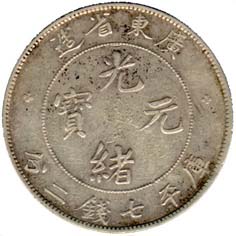 |
This dragon silver coin was minted in 1890 (3rd series) by Kwangtung Coin Bureau. In the center of the obverse are characters of "Kuang Hsu Yuan Pao" reading from top to bottom and right to left, in Chinese and Manchurian. In upper outer circle, Chinese characters "minted in Kwangtung Province", right and left small decorative stars. In lower outer circle is the description of the face value "Equivalent to 7.2 mace". In the center of the reverse is a dragon design, surrounded by stylizied clouds. encircled with the name of place of mint and face value in English, right and left are decorative stars.
In 1889, the Kwangtung Coin Bureau struck the first series of China's own silver coins in sets of 5 denominations. The main coin, 7.3 maces by weight, was valued at one foreign dollar which was 7.2 maces by weight. They were actively circulated on account of their higher percentage, with the result that they were either melted down for their excessive silver content or taken up by the collectors.
|
| Denomination: one dollar | ||
| Wt.27g. | Reverse | |
| Diam. 39.5 mm |
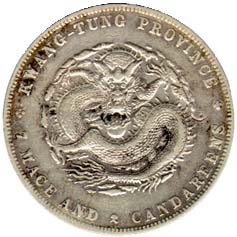 | |
| Rareness E |
| Description | Obverse | Reverse | Mint Evolution and Peculiarity |
| No. 0361 | 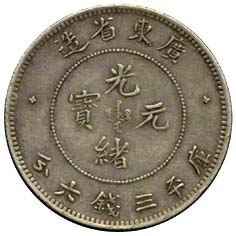 |
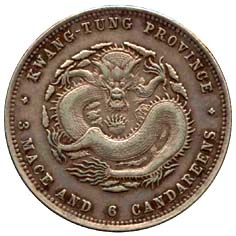 |
This 50 cents Kwangtung Silver coin (3rd series) was struck and issued during 1890 to 1908. This is the rarest type among the same series.
These 50 cents coin images are provided by 魏老三先生 of Wuhu of Anhwei Province. I would like to take this opportunity to say ''Thanks" to 魏老三先生, he is so kind as to let me use his coin images. |
| Denomination: 50 cents | |||
| Wt.13.5 g. | |||
| Diam. 34 mm | |||
| Rareness C |
| Description | Obverse | Reverse | Peculiarity |
| No. 0038 | 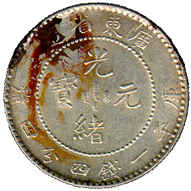 |
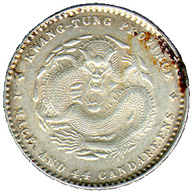 |
This 20 cents Kwangtung Silver coin (3rd series) was struck and issued during 1890 to 1908. |
| Denomination: 20 cents | |||
| Diam. 23.5 mm | |||
| Wt. 5.4 g. | |||
| Rareness E | |||
| No. 0039 | 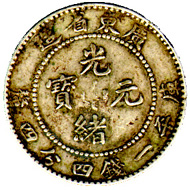 |
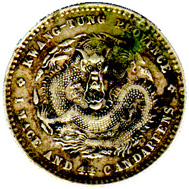 | The die of this 20 cents Kwangtung Silver coin (3rd series) was different from the above 20 cents coin. On the obverse, the second stroke of the Chinese character "Kuang" bears a bold beginning and a sharp ending. Its value is about 10 times of the above coin. bears a bold beginning and a sharp ending. Its value is about 10 times of the above coin. |
| Denomination: 20 cents | |||
| Diam. 23.5 mm | |||
| Wt. 5.4 g. | |||
| Rareness C | |||
| No. 0040 | 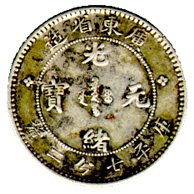 |
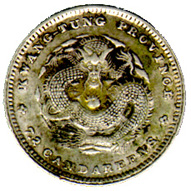 |
On the obverse of this 10 cents Kwangtung silver coin (3rd series), the composing of the middle parts of the character "Pao" is different from the above coins, it composed with a "Fou" is different from the above coins, it composed with a "Fou" is not the normal "Yee" is not the normal "Yee" . The 5 cents coin showing the same difference as this coin. . The 5 cents coin showing the same difference as this coin. |
| Denomination: 10 cents | |||
| Diam. 19 mm | |||
| Wt. 2.7 g. | |||
| Rareness E | |||
| No. 0041 | 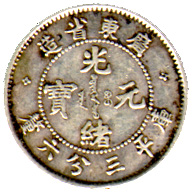 |
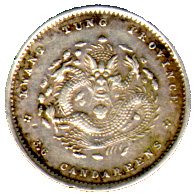 |
The die of this 5 cents Kwangtung Silver coin (3rd series) was different from all above coins. It was probably prepared by the Kwangtung Coin Bureau itself as it was of a slightly different design (the head of the dragon) and carving technique, and does not appear in the records of Heaton's Mint. |
| Denomination: 5 cents | |||
| Diam. 16 mm | |||
| Wt. 1.3 g. | |||
| Rareness D |
Mintage of Kwangtung Siver Coins
From 1889AD to 1912AD
by Kwangtung Coin Bureau
| Denominations | Mintage ( pieces ) |
| One dollar | 18,810,000 |
| 50 cents | 22,910,000 |
| 20 cents | 7,534,560,000 |
| 10 cents | 1,194,960,000 |
| 5 cents | 26,220,000 |
- - : More about Chinese Silver Dragon Coin coins:- -
 ,
,  1994, ISBN 7-5000-5469-6.
1994, ISBN 7-5000-5469-6. 78-p90, ISBN 7-218-00594-2/k.130
78-p90, ISBN 7-218-00594-2/k.130